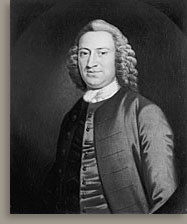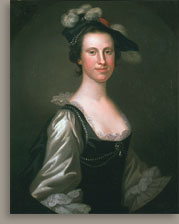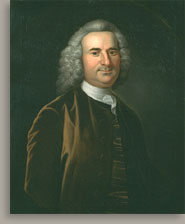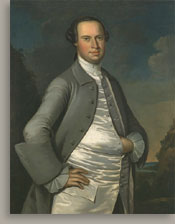 John Wollaston John WollastonCharles Willing, 1752 Description The sitter’s face is large and round. His eyebrows were formed with brown and gray strokes of paint, beneath which some flesh-colored paint can be seen. The eyelids are obscured with gray paint, but a reddish-brown line marks the bottom of the lids. Willing’s eyes are blue. The iris and large pupil are oval. A small dot of white opaque paint appears in the upper right of each pupil. In the corner of the left eye is a daub of flesh-colored paint. A white highlight running the length of the nose ends, at the tip, with a circular daub of paint. A dark, reddish-brown shadow falls along the left side of the nose. Reddish-brown shadows from the wig are visible at the hairline on both sides of the sitter’s face and below his double chin. His cheeks are red. His lips are full and appear to be outlined in gray; there is a pronounced indentation in the upper lip. The background is made up of varying shades of gray. For instance, below Willing’s face and to his left the background is relatively light, with areas of pink blended into the gray. The background becomes a darker gray at the lower left. Biography Anne and Charles’s first child, Thomas (1731–1821), was born on December 19, 1731; they had ten more children.5 After their seventh, Richard, was born, in 1744, Charles wrote: "Mrs. Charles Willing has Lately brot me another Fine Boy; & I still Flatter myself by my Endeavours Fortune will be as propitious to me in an Increase in Fortune, as it has been in mouths."6 In 1740 Charles sent young Thomas to England to be educated–probably accompanying him on the voyage–and leaving the boy in his own father’s care.7 By 1740 Willing was working independently. He frequently advertised the imported items he sold, including textiles and hardware, in the Pennsylvania Gazette.8 Periodically, he traveled to England to purchase merchandise and, on returning, typically advertised "a great Choice of . . . goods, which he sells at very low Prices, for ready Money or the usual Credit."9 He also sold servants, slaves, arms, and rum.10 Additionally, he did business as a shipowner, renting freight space and conducting a passenger service.11 A February 1754 letter to a Boston merchant, Thomas Greenough, suggests that Willing was a patron of the arts, even in his business affairs:
Not surprisingly, Willing was a prominent figure on the local scene. The family attended Christ Church, where Charles was a vestryman from 1735 to 1737 as well as in 1744, 1749, and 1750.13 Willing was among the fifty-nine subscribers to the first season of dances presented by the Philadelphia Dancing Assembly, established in the winter of 1748–49.14 He also was a founder of the University of Pennsylvania, serving as a trustee from 1749 until his death.15 A founding member of the Associators, a volunteer militia, he was captain of Company I in 1748.16 Willing was elected to the Common Council in 1743. He was a justice on the council in 1745 and on the City Court in 1747, 1749, 1752, and 1754.17 In the fall of 1748, Charles Willing was elected Philadelphia’s thirty-eighth mayor. Since each term lasted but one year, he continued conducting business while leading the city.18 In May 1754, he was elected again, this time to serve out the unfinished term of Thomas Lawrence, who had died in office.19 He was reelected in his own right in October.20 But he died on November 30 in Philadelphia, of "ship fever," just after the start of his third term. He was forty-five years old. Willing’s obituary in the Pennsylvania Gazette gives a sense of the esteem in which he was held:
This tribute was followed by the eight-stanza "Ode to the Memory of Charles Willing, Esq." 21 Willing’s wife and son Thomas were the executors of his estate. His bequests to his family included houses, land, slaves, furniture, silver, money, and family portraits.22 He was buried in the Christ Church cemetery.23 Analysis Wollaston arrived in Philadelphia from New York, where he had been painting for several years. Among his clients in 1752 was James Hamilton, Pennsylvania’s royal governor.26 Wollaston’s New York portrait John Livingston (fig. 1), probably painted just before he left for Philadelphia, shares with Charles Willing the same oval-spandrel format and bright highlights in the folds of the coat. Such coat highlighting was typical of Wollaston’s work, both in England and in the colonies. In the Willing portrait, yellow highlights were applied on top of the brown paint, used for the coat, while it was still wet and then smoothly blended. In addition, such details as the flesh-colored daub in the corner of the eye, the white highlight running the length of the nose that ends in a small circular daub, and the pronounced indentation in the top lip appear in the Livingston likeness, too.
Charles Willing remained in the family until it was sold to Robert G. Osborne, Inc., in New York, around 1969. Over the years, it was variously attributed to Benjamin West, to Gustavus Hesselius (1682–1755), and to Hesselius’s son John (about 1728-1778) as well as to Wollaston.35 In 1971 the portrait was included in the Pennsylvania Academy of the Fine Arts exhibition Philadelphia Painting and Printing to 1776. Writing in the accompanying catalogue, curator Carolyn Weekley explained the problems she had had attributing Charles Willing to Wollaston. For one, as mentioned above, it had long been thought that Wollaston did not work in Philadelphia until 1758, four years after Willing’s death. Second, Weekley noted, she was concerned by what she perceived as a difference in technique between this canvas and others Wollaston painted in Philadelphia that was not visible on the surface. Comparing the X-radiograph of the portrait done for the exhibition with those of the others, Weekley observed that all the others were marked by a strong modeling of facial features over a light-colored ground, whereas the Willing picture had areas of "impasted light-colored paint, but only limited modeling."36 Around the same time, R. Peter Mooz proposed that the American portraitist Robert Feke (1707?–1752?) had painted Charles Willing. He published this theory twice, in 1975 and in the 1978–79 issue of the Worcester Art Museum Journal. For Mooz, the then recent discovery of Willing’s will, which lists portraits of him and his wife by "Feake," supplied partial confirmation.37 The fact that the three-quarter-length portrait of Charles’s wife, Anne Shippen Willing (Henry Francis du Pont Winterthur Museum, Winterthur, Delaware), is signed and dated "R. Feke Pinx/1746" and that the picture seemed to share with Charles Willing "an identical and simultaneous line of descent with the family to the twentieth century" stood as further proof for Mooz. Like Weekley, he noted that the X-radiograph of Willing’s portrait, unlike those of the Wollaston portraits, revealed limited facial modeling and areas of thickly painted ground; this technique, he contended, was characteristic of Feke and consistent with the X-radiograph of Anne Shippen Willing’s portrait. Mooz also pointed out that the X-radiograph revealed the underlying presence of a longer wig with a knot at the shoulder–similar to those in two Philadelphia portraits, Tench Francis (Metropolitan Museum of Art, New York) and Phineas Bond (Philadelphia Museum of Art), that Feke painted in 1746. 38 In his 1750 will, Charles Willing bequeathed to his daughter Anne, "my Picture and her Mothers drawn by Feake." Although this confirms that the Willings patronized Robert Feke, it does not prove that he painted the bust-length Worcester portrait. Feke was in Philadelphia in 1746 and again in 1749–50, but during those visits he painted no bust-length likenesses. With this in mind, it seems more than likely that if Feke had portrayed Charles Willing, the image would have been a three-quarter-length to match the 1746 portrait of the subject’s wife. The Worcester painting differs markedly from Feke’s other Philadelphia portraits–for example, the likeness of Tench Francis (who was a friend of Willing). A greater number of painterly gray brushstrokes are visible in the white neck cloth and cuffs of the Feke canvas than in the Worcester bust-length. Also, Francis’s eyes have small black pupils, in contrast to Willing’s large oval pupils. Most significantly, this Feke portrait has none of the above-noted coat highlighting featured in the Charles Willing portrait. Although Mooz claimed that the provenances of Anne Shippen Willing and Charles Willing were identical, their whereabouts before 1855, when Thomas Balch recorded them as being owned by Dr. Charles Willing, remains unknown. It is not possible to claim that the portraits descended together in the family, since it is not known how or when Dr. Willing acquired them. 39 In addition, Mooz and Weekley’s interpretations of the X-radiographs were not accurate. Contrary to Mooz’s claim, the X-radiograph of Willing’s portrait reveals that only a slight adjustment was made to the wig: it appears to have been narrowed at the left and right and raised up the distance of one curl. Originally, the second curl on the right side of the sitter’s face fell just below his lower lip, instead of in its present position, slightly above the upper lip. The X-radiograph of Charles Willing contains no evidence of a long-knot wig, such as that worn by Tench Francis. Furthermore, the Willing-portrait X-radiograph does show strong facial-feature modeling, like those of Wollaston’s other Philadelphia portraits, for instance Experience Johnson Gouvenour (Mrs. Samuel Gouvenour) (about 1752, Henry Francis du Pont Winterthur Museum, Winterthur, Delaware)–a painting that coincidentally also features a similar circular daub at the tip of the nose and puffiness under the eyes.40 Charles Willing’s will makes clear that by the time he was forty, he and his wife had sat for a set of portraits besides the two by "Feake" he bequeathed to his daughter Anne: he left his daughter Dorothy "mine and her Mothers Picture drawn by Hessolioos."41 Dorothy probably took these likenesses of her parents with her when she left Philadelphia for England with her husband and young son in 1759.42 Gustavus and John Hesselius both worked in Philadelphia, and either of them could have depicted Charles Willing. Yet there are several reasons–stylistic and chronological–why neither of these artists could have produced the picture that is in the Worcester Art Museum’s collection. Gustavus Hesselius arrived in America from Sweden in 1711. He used dark colors and worked in a painterly style but often had trouble rendering anatomy. Portraits attributed to him with certainty, such as his Self-Portrait (about 1740, Historical Society of Pennsylvania, Philadelphia), indicate that he was not interested in vividly conveying the various textures represented in his paintings. It is unlikely, then, that he would have painted the sort of rich brown velvet coat seen in Charles Willing. Also, Gustavus Hesselius typically used dark backgrounds, as in James Logan (about 1728–35, Historical Society of Pennsylvania, Philadelphia), in which the sitter’s gray wig is almost entirely obscured in the background. Logan’s facial features are roughly outlined in brown paint, and there is a crude patch of white on his forehead. As for John Hesselius, his earliest-known portrait of a Philadelphian, Lynford Lardner (private collection), was done in 1749; if he was the "Hessolioos" who painted the pictures of Charles Willing and his wife mentioned in Willing’s July 1750 will, those works would have been early ones.43 Although the younger Hesselius undoubtedly trained with his father, his early portraits–such as Millicent Conway Gordon (Mrs. James Gordon) (1750, Virginia Historical Society, Richmond) and Mary Rudderow Maddox (Mrs. Joshua Maddox) (1751, Powel House, Philadelphia Society for the Preservation of Landmarks, Philadelphia)–explicitly show the influence of Robert Feke. Both likenesses are clearly derived from Feke’s Ann McCall (Mrs. Samuel McCall, Sr.) (1746, Museum of Fine Arts, Houston). For the portrait of Mrs. Gordon, Hesselius repeated the pose and elements of the costume seen in the McCall picture, including the ornament-fastened sleeves and tassels. He also copied the positions of the fingers almost exactly but did not include the flower Ann McCall holds in her proper left hand. Given this evidence, it is reasonable to surmise that a portrait painted by John Hesselius before July 1750 would reflect a greater debt to Feke than to Wollaston; and, as detailed above, the Worcester portrait of Charles Willing does not bear a resemblance to Feke’s work. Although it is easy to dismiss previous attributions of the Worcester portrait to Feke, to Gustavus Hesselius, and to the early work of John Hesselius, the later work of the younger Hesselius merits further consideration. That is because some of those later portraits do reflect Wollaston’s influence. John Hesselius lived in Philadelphia from about 1751 until after his father’s death in 1755, and he was probably there when Wollaston arrived in 1752. He no doubt encountered Wollaston portraits again after moving to Maryland in the late 1750s; eventually, he settled outside Annapolis, where Wollaston worked after leaving Philadelphia.44
It is not surprising that Charles Willing sat for three portraits, including the Worcester Art Museum portrait by John Wollaston. After his death, his widow sat for at least two more portraits: one by Charles Willson Peale (about 1772, Historical Society of Pennsylvania, Philadelphia); and the other by Matthew Pratt (1734–1805) (1784–85, private collection). And son Thomas Willing, who also had posed for Wollaston, sat to Peale (1782, Metropolitan Museum of Art, New York) and to Gilbert Stuart (about 1795, unlocated). A number of Charles Willing’s other children and grandchildren further observed the family tradition, sitting for various artists, including Peale, Pratt, Stuart, and West. Notes 2. For the elder Willing’s return to England by the end of 1730, see Pennsylvania Gazette, December 3, 1730. 3. Hare-Powel about 1907, 228. 4. Pennsylvania Gazette, April 29–May 6, 1731. It appears that Willing and Shippen were still partners five years later, when a merchant named John Goodman advertised in the Pennsylvania Gazette that he had moved his store to Front Street, next door to "Messrs. Willing and Shippen." See Pennsylvania Gazette, December 2–9, 1736. 5. Hare-Powel about 1907, 229. The other children were: Anne (1733–1812), Dorothy (1735–1782), Charles (1738–1788), Mary (1740–1814), Elizabeth (1742/43–1830), Richard (1744–1798), Abigail (1747–1791), Joseph (1749–1750), James (1750/51–1801), and Margaret (1753–1816). 6. Charles Willing, Philadelphia, to Thomas Greenough, [Boston], February 8, 1744, David S. Greenough Papers, Massachusetts Historical Society, box 4. 7. The likelihood that he accompanied Thomas is based on two notices Charles placed in the Philadelphia newspaper, near the time the boy went overseas, announcing his pending visit England. See Pennsylvania Gazette, August 28 and October 9, 1740. Charles’s father periodically reported on Thomas’s progress. See Balch 1922, 3–4; ANB, vol. 23, 530–32; and Scharf and Westcott 1884, I, 276–77. 8. See, for example, Pennsylvania Gazette, August 28 and October 9, 1740. 9. Ibid., March 19, 1741, and August 19, 1742. 10. One advertisement for his trade in servants read, "Just imported in the Ship Dorothy, John Nicholls Master, from Bristol, and to be sold by Charles Willing, A Parcel of likely Servants, Men and Boys, some bred up to Trades, and others fit for Town or Country Business." Pennsylvania Gazette, January 22, 1745. For other ads that mention servants, as well as slaves, see Pennsylvania Gazette, June 25, 1747; November 26, 1747; March 29, 1748; May 5, 1748; April 26, 1750; September 20, 1753; and November 22, 1753. Willing himself owned slaves. In his July 28, 1750, will, he bequeathed four–"my Negroe Wench Cloe," "my Negroe Girl Venus," "my Negro Man John," and "my Negro Boy Litchfield"–to his wife, daughter Dorothy, and sons Thomas and Charles, respectively. See Charles Willing, will no. 146, 1754, Philadelphia City Hall. 11. See, for example, Pennsylvania Gazette, October 21, 1742. 12. Charles Willing, Philadelphia, to Thomas Greenough, Boston, February 21, 1754, David S. Greenough Papers, Massachusetts Historical Society, box 5. 13. Washburn 1925, 293. 14. For the list of subscribers to the Philadelphia Dancing Assembly’s first season, see Balch 1914, 338–39, and idem, 1916, 22–23. 15. DuBin 1941, 3. 16. Pennsylvania Gazette, January 4, 1748; DuBin 1941, 3. 17. Jordan 1911, I, 124. 18. On October 6, 1748, the Pennsylvania Gazette reported, "Tuesday last Charles Willing Esq; was elected Mayor of this City for the ensuing Year." Willing continued to advertise his imported goods. See, for example, Pennsylvania Gazette, November 3, 1748; May 13, 1749; June 29, 1749; and August 17, 1749. Early in his term, he issued an ordinance forbidding local barbers and peruke makers from "shaving, dressing and powdering wigs and hair on Sundays, to the scandal of religion." 19. Ibid., May 2, 1754. 20. Ibid., October 3, 1754. 21. After Charles Willing died, William Plumsted was elected to fill out his mayoral term. For this information and Willing’s obituary, see Pennsylvania Gazette, December 5, 1754. 22. Charles Willing will; and Thomas Willing, Philadelphia, to Thomas Willing, [Bristol], December 6, 1754, Charles Willing and Son, Letterbook, 1754–1761, Historical Society of Pennsylvania. 23. Clark 1864, 130. 24. An advertisement for the firm of Charles Willing and Son that ran in the Pennsylvania Gazette on October 17, 1751, noted its location "At their Warehouse, in Front Street." For another ad noting the location, see Pennsylvania Gazette, April 2, 1752. I would like to thank Ellen Miles, Jules Prown, and David Steinberg, each of whom suggested that further consideration be given to the attribution of this painting to Wollaston. 25. Thomas Willing to Thomas Willing, December 6, 1754. 26. On October 20, 1752, Hamilton wrote in his cashbook, "pd. Mr. Woolaston for 2 half length Pictures __ 36–." James Hamilton Papers, 1733–1783, Historical Society of Pennsylvania, box 1, no. 1, Cashbook, 1739–1757, 22. Hamilton also paid "Wollaston" an additional seventeen pounds on September 2, 1752. See cashbook, 21. 27. For a color reproduction of Thomas Willing, see Schwarz 1982, cat. no. 7. Dorothy Willing’s older sister, Anne sat for her portrait while she was on a trip to England with her father. See Cadwalader 1929, 52. 28. For Dorothy Willing, see DNB, vol. 54, 384; Hare-Powel about 1907, 235; and Sterling 1909, I, 169. One source lists the marriage in October 1755 and includes the transcription of an August 8, 1755, letter discussing Dorothy’s engagement to Stirling. See Cadwalader 1929, 64, 76, 77, 87. Thomas did not marry until 1763, when he wed Anne McCall (1745–1781). See DuBin 1941, 8. 29. H[opkinson] 1758, 607–8. 30. The portraits Dorothy Willing and Thomas Willing were sold in a Sotheby’s London sale on February 6, 1980; David Stockwell, Inc., Centerville, Delaware, eventually purchased them. See Sotheby Parke Bernet and Co., 1980, 31, lot 74, and Antiques 136, no. 4 (October 1989): 605. Sotheby’s provenance is incorrect: the canvases probably were first joined in 1816, when Dorothy Willing Stirling’s grandson John Stirling (1786–1853) married his second cousin, Thomas Willing’s granddaughter Elizabeth Willing (1796–1874). For Dorothy and Thomas’s descendants, see Sterling 1909, I, 166, and Keith 1997, 98. 31. Weekley 1976, 227. 32. Ibid., 16. 33. Balch 1914, 338–39. 34. Charles Willing’s wig dates from the 1750s. Arnold 1970, 21. 35. The portrait was first offered to the Worcester Art Museum in 1972, as a work by Robert Feke. The museum’s director turned the offer down, writing to its owner that the picture looked like a Wollaston and not a Feke. See Richard Stuart Teitz to Robert G. Osborne, October 13, 1972. 36. Pennsylvania Academy of the Fine Arts 1971, 47; Carolyn J. Weekley, Curator, Abby Aldrich Folk Art Center, Williamsburg, Virginia, to Susan Strickler, November 23, 1981. 37. According to Mooz, "[T]he authorship of the work is established by the discovery of Willing’s will and its handwritten statement of 1754." Mooz 1975, 55. Although the will was probated in 1754, Mooz was incorrect in dating it to that year: Charles Willing wrote it on July 28, 1750, before a trip to England. See Charles Willing will. 38. Mooz 1975, 55. Also, comparing the Willing portrait to others by Wollaston, Mooz wrote that the "heads are proportioned differently and are smaller in size." This generalization is not correct. For instance, the sitters in Wollaston’s John Parke Custis and Martha Dandridge Custis (1757, Washington and Lee University, Lexington, Virginia) and John Livingston (fig. 1) have large heads. 39. Balch 1855, c. 40. Winterthur also owns an X-radiograph of the Worcester Art Museum’s Willing portrait, but it is of poor quality. Its washed-out exposure shows little of the contrast that is visible in the Worcester’s copy of the X-radiograph. Weekley and Mooz’s conclusion that the X-radiograph reveals limited modeling might be explained by the fact that they were looking at the Winterthur X-radiograph. I would like to thank Winterthur paintings conservator Mark Bockrath, who examined the two X-radiographs with me on October 14, 1999. 41. Charles Willing will. 42. Dorothy Willing Stirling’s son Walter might have retained the portraits after her death. According to Joshua Francis Fisher, in 1831, "[The walls of Walter’s residence] were covered with family pictures, among which his Mother’s family had many representatives; but I do not remember them now." Cadwalader 1929, 71–72, 88, 90, 112. 43. For Lynford Lardner, see Philadelphia Museum of Art 1976, 48–49, and Lindsey 1999, 70. 44. Doud 1969, 131–32. 45. John Wallace was a director of the Dancing Assembly, and Lynford Lardner was a member. Balch 1914, 338. 46. Despite the signs of Wollaston’s influence in Samuel Lloyd Chew, the subject’s pose actually recalls that in Hesselius’s own John Wallace (Powel House, Philadelphia Society for the Preservation of Landmarks), painted eleven years earlier, in 1751. |




